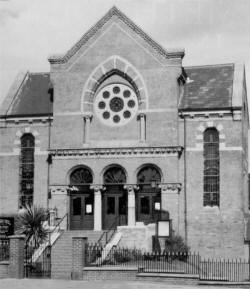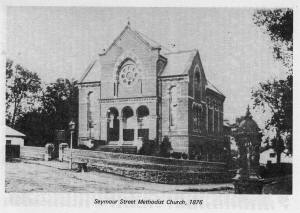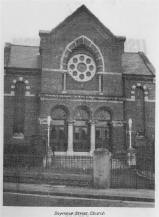 |
|
Seymour Street
Methodist Church, 2000 |
 |
 |
|
Seymour Street
Methodist Church 1876 |
Seymour Street
Methodist Church 1975 |
Introduction
2000
Most of this book was written in 1975, after
about two hundred years of Methodism in Lisburn, to celebrate
the centenary of Seymour Street Methodist Church. In 1999, as we
approached a new millennium and the 125th anniversary of the
Church, the Leaders asked me to bring the record up to date by
recording the events of the last twenty-five years.
It seemed right to retain the original book
in its entirety and to add a section which focused on recent
events, people and property. In order to ensure uniformity of
style and presentation, some minor changes have been made to the
original script. mainly to do with usage and punctuation. but
the text of the original remains virtually unaltered.
The research for the new section required my
reading more than one hundred sets of Leaders' Board minutes,
and sometimes the reading of the minutes of other committees, an
exercise which I do not recommend to anyone! Engaging in this
exercise, however, has allowed me to reflect on a sizeable
period in the life of the congregation. I have been left with
several lasting impresssions.
We should be grateful for the leadership we
have been given: it is impossible to review the work of the last
twenty-five years without recognising the commitment and
devotion of many men and women who have given faithful service
to the Kingdom of God in Seymour Street.
The congregation have been good stewards of
what has been handed on by their forebears. The work on the care
and maintenance of the property demonstrates the generosity and
self-sacrifice of many members who love their church and support
it faithfully.
It was fascinating to read, and be reminded
of, the events leading up to the building of Trinity. The
Leaders approached the idea of Church Extension with
understandable circumspection and trepidation. Much time,
energy, soul-searching and prayer were devoted to the subject.
It required considerable faith and courage, together with
visionary leadership and risk-taking, before the critical
decision was finally made. Even the most visionary of our
Leaders could scarcely have envisaged that Trinity would have
proved such a success story.
On the negative side, I could not fail to be
struck by the repeated requests for more leaders to support the
youth programme of the church. Too frequently the burden of
outreach fell on the shoulders of the few; not many people
seemed willing to give the commitment of time and energy which
is necessary for successful youth work. The Church owes a great
debt of gratitude to those few who have been so faithful.
�Top
Introduction 1975
When plans were being discussed of ways in which Seymour Street Methodist
Church might celebrate its Centenary in 1975, it was felt desirable that a
historical account of the past hundred years should be written. It soon
became obvious that something more comprehensive was called for; that to
write of the past hundred years, whilst ignoring the earlier period, would
provide a very incomplete record.
When I agreed to undertake the writing of the record I found it much
less daunting than I had feared because of the great amount of research
already carried out by Mr. Charles M. Allen. This account would not have
been written without Mr. Allen's thorough and painstaking researches, his
desire to produce an accurate and authentic historical record, his
constant help and encouragement and his willingness to discuss and
investigate any problem which arose. This Introduction is the only part of
the manuscript which he has not read. To him, and to Rev. John A. T. Fee,
who also read the script, I owe a debt of gratitude for their many,
invariably helpful, suggestions.
Many others have also assisted. Several members of the Church answered
our request for old documents, Annual Reports, and other material
connected with the Church, much of it useful. I am particularly grateful
for the help received from Mr. William Caves and Mr. Howard Stevenson.
Several of the more senior members of the congregation were able to recall
incidents going back to the 1920's and beyond. To all who helped I offer
my thanks.
I am grateful to those who lent photographs, several of which have been
used in the production, and to Mr. George Balfour, a former member of
Seymour Street Church, now residing in Enniskillen, who photographed the
church, the places associated with John Wesley, and several of the
officials. Thanks are also due to former ministers and to others who
cooperated by responding to the requests for photographs.
Finally I wish to acknowledge the help and co-operation of those who
lent me books, particularly Rev. J. Winston Good and Dr. Samuel Baxter; of
Rev. R. Desmond Morris who so willingly agreed to write the Foreword; of
Mr. John Weir, of the Wesley Historical Society, for his unfailing
courtesy and patience; and of my sister-in-law, Mrs. Gordon Wileman, who
generously agreed to type the manuscript.
I have come to respect and admire the leaders and officials of the past
hundred years. I hope, however, that those who hold office during the next
hundred years will show greater interest in preserving and retaining
records. of church activities, minutes of meetings and other potential
historical data. I should have liked to have appended accurate lists of
church officials but these are only available for the past thirty years.
However, I hope that what has been written will prove of interest, that
there are no errors of fact and few errors of judgment.
I have no doubt that the names of many worthy members have been
omitted. This, though regrettable, is almost inevitable. I apologise if
there are any glaring omissions and I accept entire responsibility for any
mistakes.
George E. Orr
July, 1975
Top
Foreword
I regard it a real privilege to be invited to write a Foreword to this
excellent record of the history of Lisburn Methodist Church.
My first word must be one of warmest congratulations on reaching such a
significant stage in the life and witness of this virile and growing
fellowship. A hundred years have passed, and I reckon that seldom has this
Church been as numerically strong or as spiritually alive as at the
present time. This is due, not only to the movement of the population, but
also to the invaluable contributions of mind and spirit given by dedicated
and devoted men and women in successive generations.
We, as a family, spent eight extremely happy years on the Circuit, and
we shall ever be grateful for the opportunity of identifying ourselves
with such generous and warmhearted people, sharing in their joys and
sorrows, and facing with them the problems, changes and challenges in
Christian Mission. Throughout that period we learned much about those good
and faithful servants who, long since, have joined the Church Triumphant.
The memories of their loyalty, devotion and sacrifice still linger on. It
is with profound gratitude that we salute our forefathers in the faith.
It is most encouraging to learn of steady progress in recent years; the
deepening of spiritual life; the energetic involvement in youth
activities; the commitment of talented young people to the service of the
Church both at Home and Overseas; and the growing concern for outreach and
mission. We rejoice in every evidence of the movement of the Holy Spirit.
Whilst every birthday brings with it a sense of nostalgia and a looking
gratefully into the past, the real purpose of our commemoration is lost if
there is not also a forward look. It would be a mistake to consider a
century of achievement without turning to the future. A wise teacher has
said: `The essential planning for the future is part of the duty of
today.' The present is ours to use as God directs. The immediate task, in
this period of change and upheaval, is of the utmost importance It may be
tough, complex and exacting, but if we have the will to do it, God will
supply the necessary resources.
Methodism is still a living branch of the Universal Church, and while
she is true to herself and all she represents, she is meaningful, relevant
and attractive. When she preaches Christ's wonderful Gospel of love,
forgiveness and renewal of life; when she nurtures and builds up her youth
in Christian faith and teaching; when she commissions her gifted laymen
and women to launch out in compassion and social concern; when she proves
she is a caring and servant Church, then, she justifies her existence. And
so, in God's name, and under His direction, we must move forward with a
real sense of gratitude for the blessings and accomplishments of the past;
with a steadfastness of purpose in the present; and with confidence' and
hope for the future. Remember that
"The power behind us is greater than the task before us." -------------
R: Desmond Morris
President of the Methodist Church in Ireland 1974/75
Top |